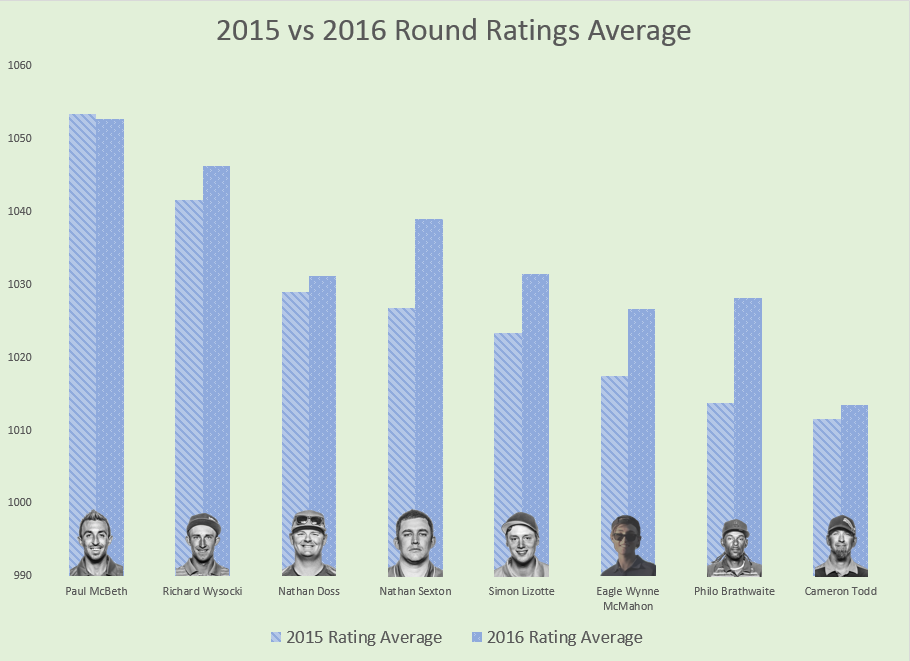The champ has been on his game, but the rest of the field is catching up.
May 19, 2016 by John Klimp in Analysis with 3 comments
After watching Paul McBeth’s phenomenal 2015, did anyone expect that we would be wondering how he has missed first place three events in a row? It’s not just the second place finishes, either; the competition this year has felt more significant. In 2015, McBeth won tournaments by an average of five strokes, and in 2016 he has been in two playoffs with multiple competitors.
McBeth’s Rating
A quick glance at McBeth’s round ratings shows consistent play in 2016. He has maintained an average round rating of 1053 – the same as 2015 – and somehow has actually been playing slightly more consistently (his standard deviation in scoring is 21 in 2015 versus 19 so far in 2016 – not statistically significant, but wow). McBeth has only been beaten by two people this year, Simon Lizotte and Cam Todd, but has been in tight contention with a number of other players. How have these players been playing compared to McBeth?
The Competition
The first step in analyzing the play of McBeth versus his competition is to review the Professional Disc Golf Association round ratings of his top competitors this year. As shown in the figure below, a number of McBeth’s competitors have seriously stepped up their game in 2016, while McBeth saw a half-point rating decrease. There are a few challenges, however, in using ratings for this analysis:
- A single stroke difference in the final round of the Glass Blown Open resulted in a rating differential of seven points at the top of the card. As a result, the gap between players may seem much greater.
- A player’s rating does not allow us to see which aspects of a specific player’s game change over time.
This is not an attack on the ratings system, just an attempt to more fully visualize performance among top players.

Another Look
The Disc Golf World Tour is doing a fantastic job of capturing advanced metrics in their events this year, but unfortunately this data is not available for any other tournaments or previous seasons. What we do have, though, is hole-by-hole scoring of PDGA events dating back to 2014.
The figure below shows the breakdown of each player’s scoring distribution by birdies, pars, and bogeys, and can be toggled between 2015 and 2016. For the purposes of simplifying this chart, any score below par is considered a birdie and any score above par is considered a bogey. Toggle back and forth between 2015 and 2016 a few times and observe the massive migration by McBeth’s competition. There is an absolute crunch effect occurring at the top cards of tournaments in 2016.
- Lizotte and Nate Sexton have both increased their birdie percentage to above 50%.
- Sexton is getting bogeys on only 6.3% of holes compared with 10.2% in 2015.
- Philo Brathwaite has nearly doubled his birdies in 2016.
- Lizotte has dropped his bogey percentage from 13.9% to 8.2%.
McBeth is still the top player in the game, but every weekend the top players on the card have a legitimate shot at taking a run for first.
Future Metrics
The analytical review of disc golf is very young, and I’d love input for what metrics are most essential in evaluating players. I’ve thrown out a number of ideas below and plan to create infographics and write-ups in the future.
| Metric | Title | Description |
|---|---|---|
| BR | Bogey Recovery | Percentage of the time a player gets a par or better after a bogey |
| BR+ | Bogey Recovery + | Percentage of the time a player gets a birdie or better after a bogey |
| GH% | Greens Hit Percentage | Being calculated now by the Disc Golf World Tour |
| ICP | Inside-the-Circle Putting | Being calculated now by the Disc Golf World Tour |
| WIN% | Win Percentage | A calculation based on historical data of how likely a player is to win a tournament after a birdie in a specific situation |
The last metric, win percentage, speaks to the real potential of maintaining a comprehensive database of tournament results. The ability to say how a player has previously performed in certain situations and the impact of certain holes on tournament outcomes will increase the quality of broadcasts and other media coverage.
Disclosure
It must be noted that, in calculating these distributions, hole-by-hole scoring is not available for every round a player throws. For players like McBeth and Ricky Wysocki, their hole-by-hole data is available for nearly every round of major tournaments they play. For other players, though, their data is only available when they have been on the top few cards.
Below I’ve outlined the number of holes of scoring available for each player by year. It’s not an outstanding amount of data, but for about half of the players it is comparable to the typical number of at-bats in a season for a baseball player. (502 plate appearances are required for baseball players to qualify for batting titles.) The good news is we can expect significantly more data in 2016. It’s a great time to be watching and playing disc golf.
| Player | 2015 Holes | 2016 Holes |
|---|---|---|
| Paul McBeth | 786 | 288 |
| Ricky Wysocki | 666 | 234 |
| Simon Lizotte | 588 | 306 |
| Nate Sexton | 324 | 270 |
| Nate Doss | 547 | 126 |
| Eagle McMahon | 261 | 143 |
| Philo Brathwaite | 126 | 324 |
| Cam Todd | 162 | 54 |